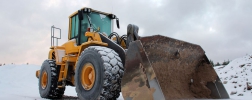Many process applications rely on either a wire-wound or thin-film resistance temperature detector (RTD) to provide efficient and safe operations. These two types of resistance thermometers have different properties, and each has its pros and cons. In reality, this is …
temperature sensor
The Problems with Verifying Thermocouple Accuracy During Reactor Startups
Robert Torgerson | Know-howRefinery operators who work with fixed bed catalysts place a high value on temperature accuracy, but they also don’t want to waste time by taking unnecessary temperature readings. Thus, to better understand any radial temperature differences that may exist during …
Combined Measurements in Mobile Working Machines: A Two-in-one Level Sensor and Temperature Sensor
Jeff Placek | LevelA growing trend in the industrial vehicles sector is to combine measuring instrumentation. This shift makes sense, as a level sensor combined with a temperature sensor, or a dual pressure–temperature transmitter, can provide more data at a lower cost than single …
How to Prevent False Alarms in Industrial Thermocouples
Adam DeLancey | TemperatureElectrical temperature measuring instruments have an alarm that warns operators of a malfunction, such as an open circuit. However, loose wires or a broken terminal block can cause the alarm to sound, even though the device itself is fine. To prevent such false alarms, …
For High-Vibration Applications, Use Rugged Pt100 Sensors
Ravi Jethra | TemperatureTurbines, pumps, and compressors produce significant vibrations, which can lead temperature measurement instruments to give incorrect readings and cause premature sensor failure. Pt100 RTDs can withstand several times more vibration than standard elements, making them …






